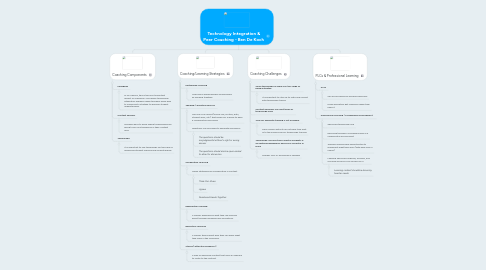
1. Coaching Components
1.1. Pedagogy
1.1.1. In my opinion, this is the most important aspect of coaching! Successful technology integration happens when teachers know how to implement a strategy to develop student understanding.
1.2. Content Specific
1.2.1. Teachers have to know which technologies are going to be most beneficial in their content area.
1.3. Technology
1.3.1. It is important to use technology for the sake of advancing student learning and understanding
2. Coaching/Learning Strategies
2.1. Partnership Learning
2.1.1. Learning is shared equally among peers by working together
2.2. Thinking / Question Devices
2.2.1. The use of an object (movie clip, picture, data, student work, etc.) that allows for a group to have a collaborative discussion
2.2.2. Questions can be posed to generate discussion
2.2.2.1. The questions should be nonjudgmental without a right or wrong answer
2.2.2.2. The questions should also be open-ended to allow for discussion
2.3. Cooperative Learning
2.3.1. These strategies are collaborative in context:
2.3.1.1. Think-Pair-Share
2.3.1.2. Jigsaw
2.3.1.3. Numbered Heads Together
2.4. Experiential Learning
2.4.1. A learner experiences what they are learning about through modeling and simulations.
2.5. Reflection Learning
2.5.1. A learner thinks about how they can apply what they learn in the classroom
2.6. Stories ("attention grabbers")
2.6.1. A way of delivering content that uses an example to relate to the content.
3. Coaching Challenges
3.1. Some technology is always on the verge of being outdated
3.1.1. It is important to stay up-to-date and current with technology trends
3.2. Content decisions can limit types of technology used
3.3. Time for adequate training is not available
3.3.1. Many school districts do not have time built in to the school year for technology training
3.4. Technology use may take a shift in mindsets if an existing pedagogical belief is in currently in place
3.4.1. Teacher 'buy-in" and belief is needed!
4. PLCs & Professional Learning
4.1. PLCs
4.1.1. Can be synchronous and asynchronous
4.1.2. Helps educators get resources when they need it
4.2. Professional Learning / Professional Development
4.2.1. Should be technology rich
4.2.2. Delivered through a coaching model in a collaborative environment
4.2.3. Teachers should have opportunities to implement what they learn (with help from a coach)
4.2.4. Learning should be ongoing, focused, and occuring DURING THE WORK DAY!
4.2.4.1. Learning content should be driven by teacher needs

